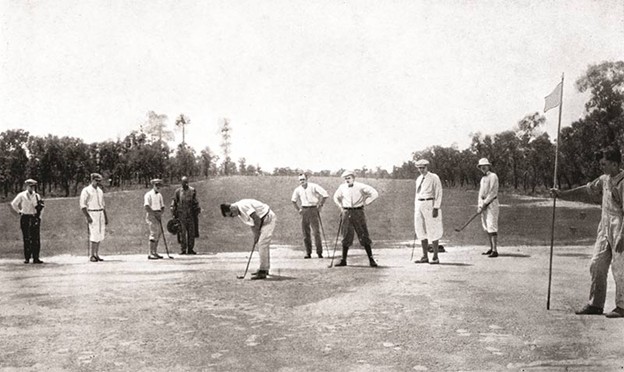Your cart is currently empty!
History of Indoor Golf

Indoor golf has an interesting history that ties together golf’s popularity, technology, and the desire to play year-round regardless of weather. Here’s an overview of its development:

Early Beginnings
(Late 1800s – Early 1900s)
- As golf spread from Scotland to other parts of the world in the late 19th century, people began looking for ways to practice indoors, especially in cold or rainy climates.
- The earliest versions of indoor golf were simple: putting carpets, nets for hitting balls, and mechanical putting games in homes, clubs, or hotels.
- In the early 1900s, some London gentlemen’s clubs and New York social clubs had “golf rooms” where players hit into nets.
Mid-20th Century
Golf Simulations & Entertainment
- Indoor golf evolved as a form of entertainment. Bars and lounges began offering mechanical putting games, sometimes coin-operated.
- By the 1960s and 70s, companies developed projection-based systems: players hit a real ball into a screen, and the machine estimated distance and direction based on impact sensors. These early simulators were quite basic, but they were groundbreaking at the time.
1980s–1990s
The Rise of Golf Simulators
- With advances in computing and sensors, golf simulators became more realistic.
- Launch monitors—measuring swing speed, ball speed, and spin—emerged, providing more accurate feedback.
- Some high-end country clubs, training centers, and even private homes installed simulators, though they were expensive and space-consuming.
2000s–2010s
Technology Boom
- Companies like Full Swing, TrackMan, and Foresight Sports revolutionized indoor golf. Their simulators used radar, high-speed cameras, and advanced software to create highly accurate ball flight data.
- Realistic 3D renderings of famous golf courses (e.g., Pebble Beach, St. Andrews) became available.
- Indoor golf centers began to emerge in cities worldwide, offering “virtual golf” experiences that combined sport and socializing—similar to bowling alleys.
2020s
Mainstream Popularity
- Indoor golf exploded in popularity during the COVID-19 pandemic, as golfers sought safe, year-round play.
- The rise of entertainment-focused venues like Topgolf Swing Suite, Five Iron Golf, and X-Golf combined simulators with food, drinks, and social atmospheres.
- Affordable home simulators also became popular, allowing enthusiasts to set up personal golf studios in basements or garages.
Today &
The Future
- Indoor golf now serves both as a serious training tool (for pros and amateurs) and as a social activity.
- Advances in AI, VR, and AR are making simulators even more immersive.
- The industry is growing rapidly, with indoor golf leagues, tournaments, and esports-like competitions becoming common.

